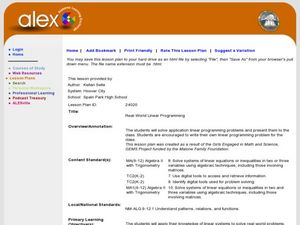Fluence Learning
Writing a Narrative: How Bear Lost His Tail
After reading the first, second, and third parts of "How Bear Lost His Tail", third grade writers answer questions about the story by completing a series of options, including discussion points. Then, they begin to plan a new narrative...
Advocates for Human Rights
The Right to a Clean Environment: Water
First, young citizens learn about water consumption by doing some research themselves on their home water usage and sharing their findings with the class. Then, they do some brainstorming and devise a plan to reduce water consumption.
Curated OER
Real-World Linear Programming
Explore linear programming on a website game. Partners solve a real-world problem by setting up an objective function and a linear inequality. They graph their results on chart paper and also using a calculator before presenting their...
New York State Education Department
TASC Transition Curriculum: Workshop 7
Designed specifically for math instructors, the seventh workshop of a 15-part series allows time to explore Webb's DOK, ponder open-ended questions, and create lessons to apply what is learned. Teachers craft high-quality math problems...
National Autistic Society
Autism Awareness
Planning activities for Autism Awareness Month? Check out the ideas in a packet designed to raise awareness of autism. Suggestions include plans for an assembly to launch a school-wide focus, lesson plans for classroom activities,...
August House
Why Koala Has a Stumpy Tail
Learn about the animals of Australia with a language arts lesson about an Australian folktale called, Why Koala Has a Stumpy Tail. After reading the story as a class, kids discuss events and characters from the book, retell the...
American Statistical Association
Armspans
Young mathematicians collect data on the arm spans of classmates. Then they sort the data by measures of center, spread, and standard deviation. Finally, they compare groups, such as boys and girls, to interpret any differences.
Curated OER
Dollars and Sense
Fourth graders read "Starting a Business" and answer the question: "How could you design an ad to let the community know about the business described in the story?" Then, they illustrate a written ad that could be posted in the...
August House
Anansi Goes to Lunch - Pre-Kindergarten
In a multidisciplinary lesson plan, you will focus your instruction around the West African folktale, Anansi Goes to Lunch by Bobby and Sherry Norfolk while your little learners sing songs, play games, participate in a grand...
EngageNY
Modeling Riverbeds with Polynomials (part 1)
Many things in life take the shape of a polynomial curve. Learners design a polynomial function to model a riverbed. Using different strategies, they find the flow rate through the river.
Teach Engineering
A Simple Solution for the Circus
Class members are challenged to design a device that will move a circus elephant into a train car. Groups brainstorm ideas that use simple machines to load the elephant. They then choose one of their ideas, sketch a plan, and present it...
EngageNY
Piecewise and Step Functions in Context
Looking for an application for step functions? This activity uses real data to examine piecewise step functions. Groups create a list of data from varying scenarios and create a model to use to make recommendations to increase...
Equality and Human Rights Commission
Learning area 4: Learn About the Meaning of Community
Scholars examine the jobs found in their community by way of surveying. After collecting data, pupils analyze their findings and share their observations with their peers. A video sparks interest. Two posters motivate participants to...
Curated OER
Real-life Problems: Dollars and Cents
Do your fourth graders love money? They'll solve these money math word problems with ease! Six word problems involving money prompt pupils to use addition, subtraction, multiplication, and division. A section for work reinforces the...
EngageNY
Informal Proof of the Pythagorean Theorem
Prove the Pythagorean Theorem using multiple informal proofs. Scholars first develop an understanding of the origins of the Pythagorean Theorem through proofs. They round out the lesson by using the theorem to find missing side lengths...
EngageNY
Surface Area
Explore finding the surface area of composite figures. Building on the previous lessons in the 29-part series, the 24th installment examines the surface area of three-dimensional solids. The focus is on decomposing composite figures and...
Other popular searches
- Autism Lesson Plans Math
- Baseball Lesson Plans Math
- Dinosaurs Lesson Plans Math
- Halloween Math Lesson Plans
- Elementary Math Lesson Plans
- Christmas Math Lesson Plans
- Saxon Math Lesson Plans
- 5e Lesson Plans Math
- Lesson Plans Math
- Lesson Plans College Math
- Free Math Lesson Plans
- Esl Math Lesson Plans















